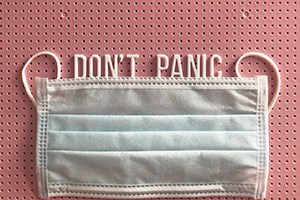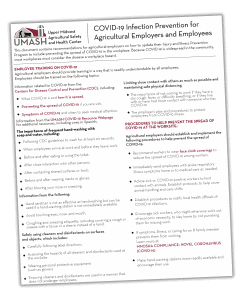
JULY 2020
The sun is shining, and the birds are chirping. All I want to do is go to the fair. I can imagine the cheese curds, the laughter, the 4Hers showing off their livestock. To be around other humans? What a blessing that would be. But then I think about my friend’s father, who contracted COVID-19, and I wonder what would happen if my aging parents got sick.
You see the statistics, the news, the reports, and it all feels so far away, but get this. As of June 26, the rate at which people are getting COVID-19 is increasing across the rural US. Iowa and Wisconsin are currently Upper Midwest hotspots. Wisconsin, for example, is seeing more than a 50% increase in COVID-19 cases during the past 14 days. This is concerning given that many farmers do not have health insurance. Costs to treat COVID-19 can be expensive.
At UMASH, we reached out to our Advisory Board and other farmers for input and ideas to keep COVID 19 away from the farm and workplace.
Here are their suggestions:
- Keep everyone up-to-date by sharing information during physically distanced daily stretches, with posters, and through texts, emails, phone calls, and videos.
- Provide training for new technology, like Zoom or Microsoft Teams
- Place an “X” on the ground more than 6 feet apart so people know where to stand.
- Create on-line accounts so workers can order groceries.
- Try to do as much as possible away from the farm, like hiring, paperwork, meetings, etc.
- Create additional handwashing stations, and put them near often-used locations.
- Have everyone wear gloves.
- After each use, clean and disinfect machinery and equipment in a safe way.
- In the case you or someone gets sick, have an emergency list of community members who can help with easy, safe, and physically distanced tasks. This can include things like delivering farm products or essentials like groceries.
- Have the same people work together each day.
- For larger farms with more employees, place workers in certain areas, like a specific barn, where they will work each day.
- Stagger the time that workers start and stop so that different shifts aren’t crossing paths.
This can also be helpful for people who don’t have good childcare options and need to work earlier or later in the day. - Create an area for sick workers before they return home or go to the hospital. Call your local public health office to see if there are ways they can help.
- Create a separate area to screen workers. Remember that what a worker says they feel is as important as the thermometer, since not everyone with COVID-19 develops a fever.
- Have only one person or people who live together ride in a vehicle at a time.
- Have visitors and employees wear masks.
- Have extra masks on hand for workers and visitors.
- Move chairs and lunch tables so they’re farther apart.
- Wipe down frequently-used surfaces often. This includes microwaves, chairs, refrigerators, and light switches.
- When a worker gets COVID-19, wipe down walls, countertops, etc.
- Create paid COVID-19 leave, which is different from regular paid-time-off (PTO).
- Don’t share PPE, like safety glasses.
There’s a reason for the “I” in COVID. I need to do my part to prevent the spread of COVID-19, and so can you.
 For More Guidance:
For More Guidance:
Visit the latest CDC/U.S. Department of Labor guidelines and our COVID-19 Infection Prevention for Agricultural Employers and Employees guide.
ENGLISH SPANISHAdditional Resources:
- Farm Safety Check: COVID-19 Infection Prevention
Upper Midwest Agricultural Safety and Health Center (UMASH) - Enfermedad del coronavirus 2019 (COVID-19)
Minnesota Department of Health - List N: Disinfectants for Use Against SARS-CoV-2 (COVID-19)
United States Environmental Protection Agency - COVID-19 Downloadable Materials
Pacific Northwest Agricultural Safety and Health Center (PNASH) - COVID-19 Information for Ag Workers (July 2020)
Great Plains Center for Agricultural Health (GPCAH) - Coronavirus Resources
High Plains Intermountain Center for Agricultural Health and Safety (HICAHS) - Coronavirus Resources
National Milk Producers Federation - COVID-19: Communication Materials
Pan American Health Organization - COVID-19 Fact Sheets
Health Literacy Project
This story was published July 8, 2020.
